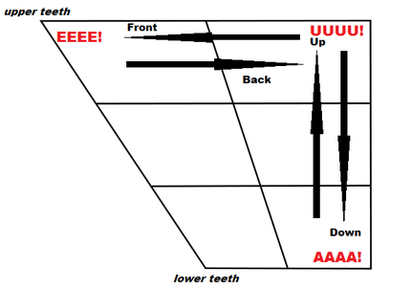Sound Primer TOC | Introduction | SF Introduction | SF Pt. 1 | SF Pt. 2 | SF Pt. 3 | Syllable Initials
Syllable Finals
Mandarin has a pre-defined set of possible syllables, and these syllables are composed of an Initial and a Final. The Initial will be a consonant sound (like /b/ or /s/), and the Final will be the combination of some vowel sounds. In this section, we will examine all of the possible Syllable Finals of Mandarin. Before you look at the Finals in detail, you need to first understand what a vowel sound is.
What is a Vowel Sound?
Traditionally, we learn in school that there are five vowels "a...i...u...e...o...(and sometimes y!)."
The reality is much more complex than this. In English, there are actually upwards of 16 distinct vowel sounds. We just happen to transcribe them using five vowel letters. So, the vowel sounds in the words "food", "good", "god" and "go" are all different but all use the letter "o."
The moral of the story is that you need to separate vowel sound and vowel script in your mind, because English vowel scripts are bad representations of the differences between vowel sounds. It should be no surprise that English vowels are also incompatible with Mandarin sounds.
The reality is much more complex than this. In English, there are actually upwards of 16 distinct vowel sounds. We just happen to transcribe them using five vowel letters. So, the vowel sounds in the words "food", "good", "god" and "go" are all different but all use the letter "o."
The moral of the story is that you need to separate vowel sound and vowel script in your mind, because English vowel scripts are bad representations of the differences between vowel sounds. It should be no surprise that English vowels are also incompatible with Mandarin sounds.
Vowel Tuning
As an English speaker you have certain vowel tendencies that will interfere with learning Mandarin vowels. On the following page, I'll show you how to produce these sounds.
Before I can give you any directions, you will need to understand what a vowel is. A vowel sound occurs when you let voiced air flow out unimpeded through your mouth (if you impede it, you have a consonant sound).
The acoustic qualities of the vowel are determined by the position of your tongue, which can move up and down or back and forward inside of your mouth.
Before I can give you any directions, you will need to understand what a vowel is. A vowel sound occurs when you let voiced air flow out unimpeded through your mouth (if you impede it, you have a consonant sound).
The acoustic qualities of the vowel are determined by the position of your tongue, which can move up and down or back and forward inside of your mouth.
The Pros and Cons of Pinyin
Mandarin already has several phonetic respelling systems, the most popular of which being Pinyin. Pinyin does a good job of consistently representing Mandarin sounds with roman letters, but it is far from perfect. For example, the vowel sound in the syllable "dan", is different from the vowel sound in the syllable "dian", even though the same letter, "a", is used to represent them. These sort of inconsistencies can confuse learners a lot.
Nevertheless, you will have to learn pinyin at some point, so its better to learn it now than to spend time learning a whole new phonetic system. Also, the minor sound-script discrepancies like the dan-dian example are few and follow specific patterns, so it should not be difficult for you to get a feel for them.
On the next page, you will go over all the possible endings for Mandarin syllables, focusing on your pronunciation of the vowel sounds. Listen closely to the audio and try to mimic the pronunciation exactly. I've included pronunciation notes on the syllables that are problematic for English speakers.
Nevertheless, you will have to learn pinyin at some point, so its better to learn it now than to spend time learning a whole new phonetic system. Also, the minor sound-script discrepancies like the dan-dian example are few and follow specific patterns, so it should not be difficult for you to get a feel for them.
On the next page, you will go over all the possible endings for Mandarin syllables, focusing on your pronunciation of the vowel sounds. Listen closely to the audio and try to mimic the pronunciation exactly. I've included pronunciation notes on the syllables that are problematic for English speakers.
Once you have completed this page, you may move on to the next section - Syllable Finals Part 1.
Sound Primer TOC | Introduction | SF Introduction | SF Pt. 1 | SF Pt. 2 | SF Pt. 3 | Syllable Initials


